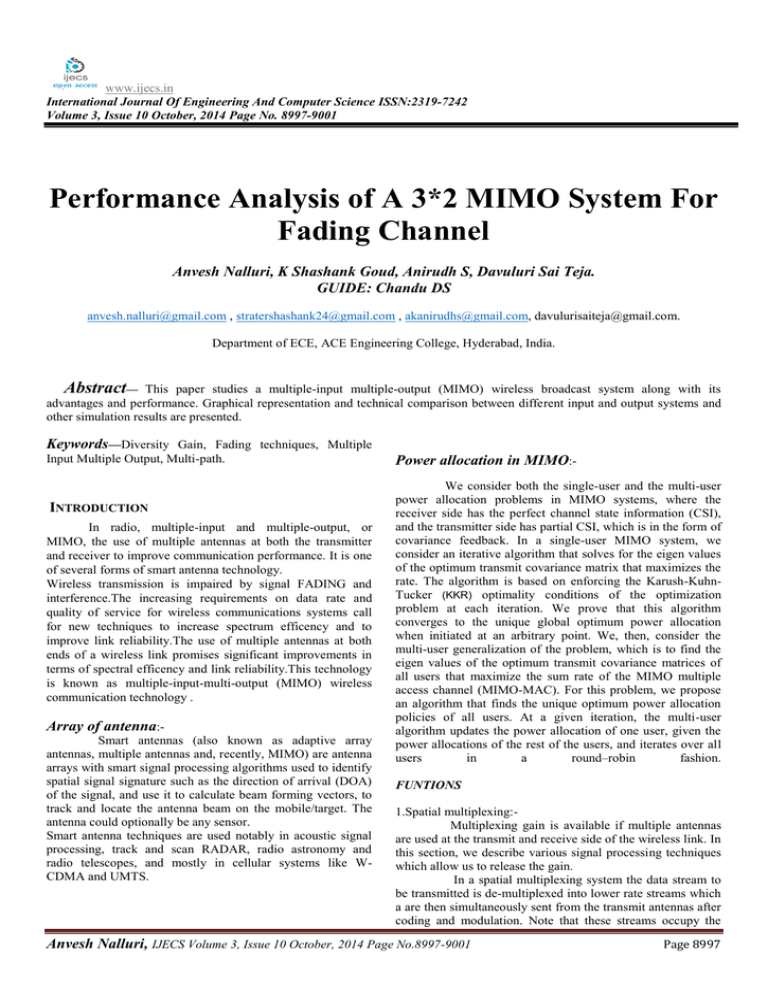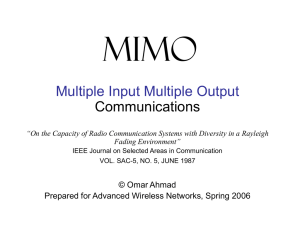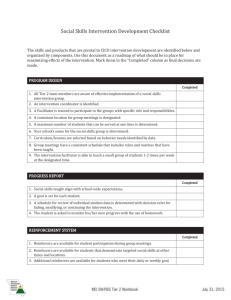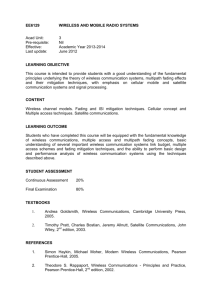www.ijecs.in International Journal Of Engineering And Computer Science ISSN:2319-7242
advertisement

www.ijecs.in International Journal Of Engineering And Computer Science ISSN:2319-7242 Volume 3, Issue 10 October, 2014 Page No. 8997-9001 Performance Analysis of A 3*2 MIMO System For Fading Channel Anvesh Nalluri, K Shashank Goud, Anirudh S, Davuluri Sai Teja. GUIDE: Chandu DS anvesh.nalluri@gmail.com , stratershashank24@gmail.com , akanirudhs@gmail.com, davulurisaiteja@gmail.com. Department of ECE, ACE Engineering College, Hyderabad, India. Abstract— This paper studies a multiple-input multiple-output (MIMO) wireless broadcast system along with its advantages and performance. Graphical representation and technical comparison between different input and output systems and other simulation results are presented. Keywords—Diversity Gain, Fading techniques, Multiple Input Multiple Output, Multi-path. INTRODUCTION In radio, multiple-input and multiple-output, or MIMO, the use of multiple antennas at both the transmitter and receiver to improve communication performance. It is one of several forms of smart antenna technology. Wireless transmission is impaired by signal FADING and interference.The increasing requirements on data rate and quality of service for wireless communications systems call for new techniques to increase spectrum efficency and to improve link reliability.The use of multiple antennas at both ends of a wireless link promises significant improvements in terms of spectral efficency and link reliability.This technology is known as multiple-input-multi-output (MIMO) wireless communication technology . Array of antenna:Smart antennas (also known as adaptive array antennas, multiple antennas and, recently, MIMO) are antenna arrays with smart signal processing algorithms used to identify spatial signal signature such as the direction of arrival (DOA) of the signal, and use it to calculate beam forming vectors, to track and locate the antenna beam on the mobile/target. The antenna could optionally be any sensor. Smart antenna techniques are used notably in acoustic signal processing, track and scan RADAR, radio astronomy and radio telescopes, and mostly in cellular systems like WCDMA and UMTS. Power allocation in MIMO:We consider both the single-user and the multi-user power allocation problems in MIMO systems, where the receiver side has the perfect channel state information (CSI), and the transmitter side has partial CSI, which is in the form of covariance feedback. In a single-user MIMO system, we consider an iterative algorithm that solves for the eigen values of the optimum transmit covariance matrix that maximizes the rate. The algorithm is based on enforcing the Karush-KuhnTucker (KKR) optimality conditions of the optimization problem at each iteration. We prove that this algorithm converges to the unique global optimum power allocation when initiated at an arbitrary point. We, then, consider the multi-user generalization of the problem, which is to find the eigen values of the optimum transmit covariance matrices of all users that maximize the sum rate of the MIMO multiple access channel (MIMO-MAC). For this problem, we propose an algorithm that finds the unique optimum power allocation policies of all users. At a given iteration, the multi-user algorithm updates the power allocation of one user, given the power allocations of the rest of the users, and iterates over all users in a round–robin fashion. FUNTIONS 1.Spatial multiplexing:Multiplexing gain is available if multiple antennas are used at the transmit and receive side of the wireless link. In this section, we describe various signal processing techniques which allow us to release the gain. In a spatial multiplexing system the data stream to be transmitted is de-multiplexed into lower rate streams which a are then simultaneously sent from the transmit antennas after coding and modulation. Note that these streams occupy the Anvesh Nalluri, IJECS Volume 3, Issue 10 October, 2014 Page No.8997-9001 Page 8997 same frequency band. Each receive antenna observes a superposition of the transmitted signals. The receiver then separates them into constituent data streams and remultiplexes them to recover the original data stream. 2. Transmit Diversity:Transmit diversity is a technique which realizes spatial diversity gain in systems with multiple transmit antennas without requiring channel knowledge in transmitter. WITHOUT ENCODER AND COMBINER :In this simulation process, the encoder and combiner are removed, so as to specify the significance of antenna in change in the rate of fading. Bernoulli binary generator is converted to BPSK modulator baseband which is directly connected to fading channel leaving behind the encoder. Fading channel and AWGN are connected to BPSK demodulator baseband which is connected to error rate calculation and is displayed with the help of a Display. Multi-Path:Multi-Path occurs when the different signals arrive at the receiver at various times. In an Urban environment, these signals will bounce off trees, buildings or any other obstacles and continue on their way to their destination ( the receiver) but in different directions. MIMO takes the advantage of multi-path. Fading:In wireless communications, fading is deviation of the attenuation affecting a signal over certain propagation media. The fading may vary with time, geographical position or radio frequency, and is often modeled as a random process. A fading channel is a communication channel comprising fading. In wireless systems, fading may either be due to multipath propagation, referred to as multi-path induced fading, or due to shadowing from obstacles affecting the wave propagation, sometimes referred to as shadow fading. Fading signals occur due to reflections from ground & surrounding buildings (clutter) as well as scattered signals from trees, people, towers, etc. Multipath signals have randomly distributed amplitudes, phases, & direction of arrival. Received signal strength can vary by Small-scale fading over distances of a few meter (about 7 cm at 1 GHz)! FADING IN WIRELESS COMMUNICATION :1. In wireless communication, signal fading is caused by multi-path effect. Multi-path effect means that a signal transmitted from a transmitter may have multiple copies travelling through different paths to reach a receiver. 2.At the receiver, the received signal should be the sum of all these multi-path signals. Because travelled by these signals are different; some are longer and some are shorter. 3.The one at the direction of light of signal (LOS) should be the shortest.. These signals interact with each other. If signals are in phase, they would intensify the resultant of the signal, otherwise, the resultant signal is weakened due to out of phase. This phenomenon is called channel fading EFFECTS OF FADING :1. Rapid changes in signal strengths over small travel distances or short time periods. 2. Changes in the frequency of signals. 3. Multiple signals arriving a different times. When added together at the antenna, signals are spread out in time. This can cause a smearing of the signal and interference between bits that are received. Anvesh Nalluri, IJECS Volume 3, Issue 10 October, 2014 Page No.8997-9001 Page 8998 BLOCK DIAGRAM OF OSTBC ENCODER AND COMBINER :- WITH ENCODER AND COMBINER:- Binary Bernoulli generator is used to send random data. BPSK modulator baseband is used to modulate waveform by using BPSK technique, which encodes waveform using a rate ¾ encoder, for that OSTBC Encoder is used. The encoded data is further sent to fading channel. AWGN which is connected to the other end of fading channel carries the rate for transmission. The data is now sent to OSTBC combiner which multiplies the rate with encoded data. BPASK demodulator baseband is used so that the random data is a bit de-modulated. Error rate calculator is used to calculate the amount of error accumulated during the process. Display is also connected to display the error accumulated. Simulation gives the comparision demodulated data and transmitted data. DISCUSSIONS AND RESULTS between These simulations show the rate of error occurred with and without encoder and demodulator. The difference in the rate of error is the major aspect to be noticed. This difference is due to the antenna system which is used to reduce the noise and transmit or receive the distortion less signal. Fading is reduced up to maximum extend by usage of MIMO. Without using encoder and combiner in the system , the error rate is 100%. With encoder and combiner the error rate is decreased to 10%. Therefore, from the above results we can say that, maximum fading is reduced using MIMO system. Reduction of fading:Fading is the most important cause of distortion that detracts from the enjoyment program material transmitted on shortwave. Fading occurs on strong signals and weak signals. Increasing the transmitter power does little to improve the distortion caused by fading. An analysis of the different causes of fading is presented this month along with some ideas on Anvesh Nalluri, IJECS Volume 3, Issue 10 October, 2014 Page No.8997-9001 Page 8999 measures broadcasters and listeners can take to reduce the effects of fading. By using MIMO technique, we can reduce fading. APPLICATIONS :1. Spatial multiplexing techniques make the receivers very complex, and therefore they are typically combined with Orthogonal frequency-division multiplexing (OFDM) or with Orthogonal Frequency Division Multiple Access (OFDMA) modulation, where the problems created by a multi-path channel are handled efficiently Summary and Conclusions:1. MIMO Systems are getting us closer to the 1Gbps landmark 2. At the same time, they provide reliable communications 3. Different architectures available for use. References:[1].W.C.Y Lee, Mobile communications, New York: Mc Gram-Hill, 1982 2. WLAN-WIFI [2]W.C.Jakes, Microwave York:Wiley,1974 3. Mesh Networks [3]V.Tarokh, H.Jafarkhani and A.R.Calderbank,”Space time block codes from orthogonal designs” IEEE Trans.Inf.Theory,vol.45,pp.1456-1467,July 1999. 4.4G 5. Digital Home 6. MIMO is also planned to be used in mobile radio telephone Advantages:1. Increased capacity, robustness. 2. MIMO systems add more flexibility to Communication system. 3. MIMO is a promising techniques for the next generation of wireless communications. 4. It reduces the fading and interference . mobile communications,New [4]T.L.Marzetta and B.M.Hockwald,”Capacity of a mobile multiple-antenna communication link in Rayleigh flat fading, “IEEE Trans .Inf .Theory, vol.45,pp.139-157,Jan .1999. [5]A.J.Paulraj and T.Kailath,”Increasing capacity in wireless broadcast systems using distributed transmission/directional reception,” [6]Ezio Biglieri, Robert Calderbank and H.Vincent Poor, MIMO wireless communications, Cambridge BIBLIOGRAPHY:- 1.Author :- Anvesh Nalluri Pursuing B.tech 4th year branch :- Electronics and Communication engineering college :- ACE Engineering College 2. Author :- K.Shashank Goud Pursuing B.tech 4th year branch :- Electronics and Communication engineering college :- ACE Engineering College Anvesh Nalluri, IJECS Volume 3, Issue 10 October, 2014 Page No.8997-9001 Page 9000 3. Author :- Anirudh S Pursuing B.tech 4th year branch :- Electronics and Communication engineering college :- ACE Engineering College 4. Author :- Davuluri Sai Teja Pursuing B.tech 4th year branch :- Electronics and Communication engineering college :- ACE Engineering College 5.Guide :- Chandu DS Received his bachelors degree in electronics and communication engineering from AVANTHI Institute of Engineering and Technology, JNTU, Hyderabad. He has a post Graduate degree in communication systems from JNTU, Hyderabad. He has three journal and two conference papers to his credit. He is a member of IEEE and he is currently working as assistant professor in ACE Engineering College. His research areas include propogation model and antenna design. Anvesh Nalluri, IJECS Volume 3, Issue 10 October, 2014 Page No.8997-9001 Page 9001




